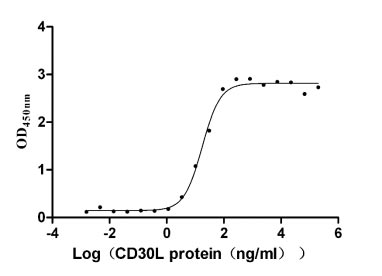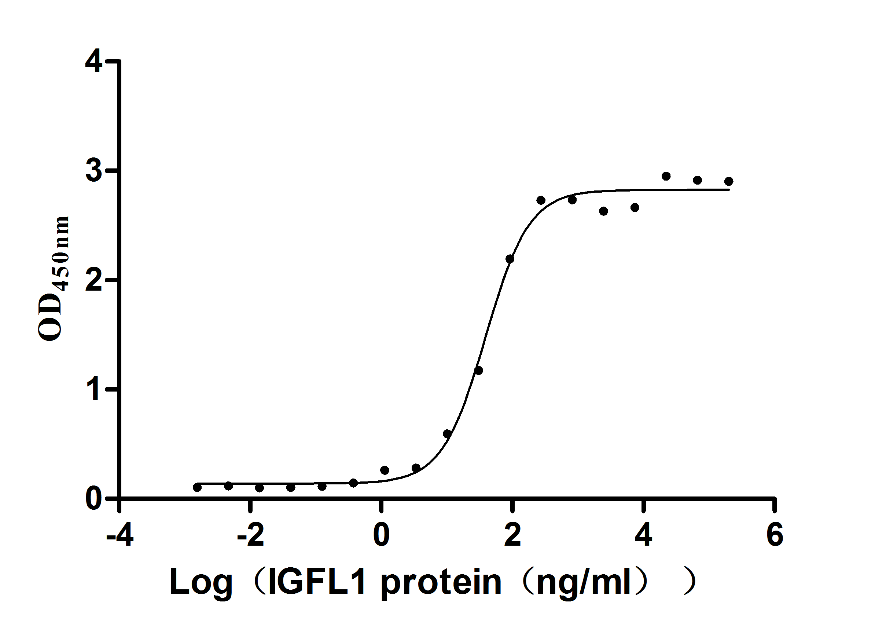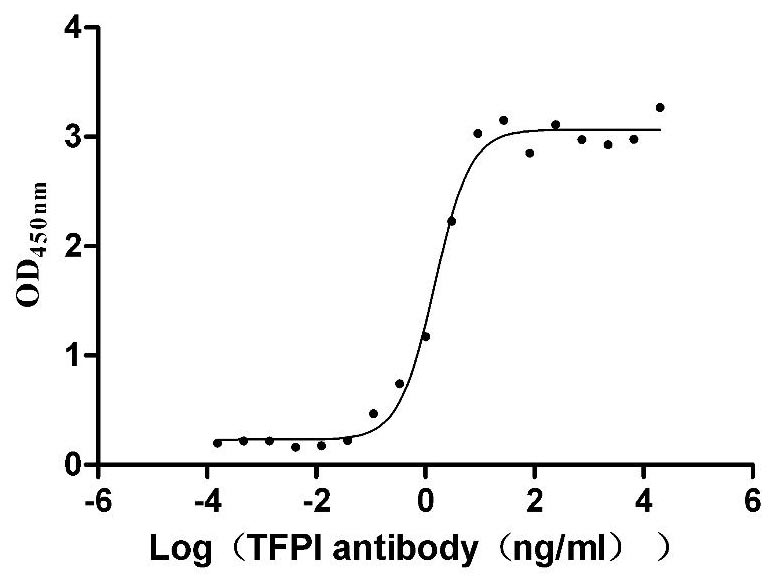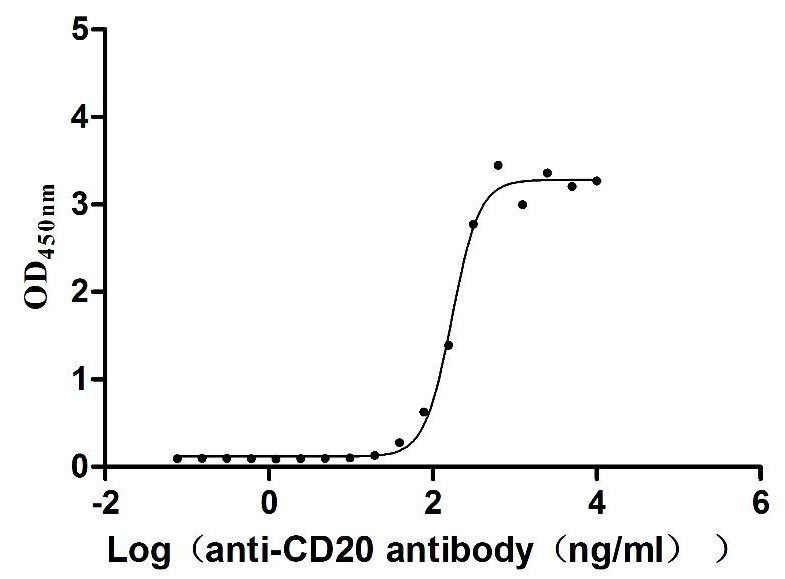Recombinant Mouse Peptidyl-prolyl cis-trans isomerase FKBP5 (Fkbp5)
-
货号:CSB-YP723740MO
-
规格:
-
来源:Yeast
-
其他:
-
货号:CSB-EP723740MO
-
规格:
-
来源:E.coli
-
其他:
-
货号:CSB-EP723740MO-B
-
规格:
-
来源:E.coli
-
共轭:Avi-tag Biotinylated
E. coli biotin ligase (BirA) is highly specific in covalently attaching biotin to the 15 amino acid AviTag peptide. This recombinant protein was biotinylated in vivo by AviTag-BirA technology, which method is BriA catalyzes amide linkage between the biotin and the specific lysine of the AviTag.
-
其他:
-
货号:CSB-BP723740MO
-
规格:
-
来源:Baculovirus
-
其他:
-
货号:CSB-MP723740MO
-
规格:
-
来源:Mammalian cell
-
其他:
产品详情
-
纯度:>85% (SDS-PAGE)
-
基因名:
-
Uniprot No.:
-
别名:Fkbp5; Fkbp51Peptidyl-prolyl cis-trans isomerase FKBP5; PPIase FKBP5; EC 5.2.1.8; 51 kDa FK506-binding protein; 51 kDa FKBP; FKBP-51; FK506-binding protein 5; FKBP-5; Rotamase
-
种属:Mus musculus (Mouse)
-
蛋白长度:full length protein
-
表达区域:1-456
-
氨基酸序列MTTDEGTSNN GENPAATMTE QGEDITTKKD RGVLKIVKRV GTSDEAPMFG DKVYVHYKGM LSDGKKFDSS HDRKKPFAFS LGQGQVIKAW DIGVSTMKKG EICHLLCKPE YAYGSAGHLQ KIPSNATLFF EIELLDFKGE DLFEDSGVIR RIKRKGEGYS NPNEGATVKV HLEGCCGGRT FDCRDVVFVV GEGEDHDIPI GIDKALVKMQ REEQCILYLG PRYGFGEAGK PKFGIDPNAE LMYEVTLKSF EKAKESWEMD TKEKLTQAAI VKEKGTVYFK GGKYTQAVIQ YRKIVSWLEM EYGLSEKESK ASESFLLAAF LNLAMCYLKL REYNKAVECC DKALGLDSAN EKGLYRRGEA QLLMNDFESA KGDFEKVLAV NPQNRAARLQ ISMCQRKAKE HNERDRRVYA NMFKKFAERD AKEEASKAGS KKAVEGAAGK QHESQAMEEG KAKGHV
-
蛋白标签:Tag type will be determined during the manufacturing process.
The tag type will be determined during production process. If you have specified tag type, please tell us and we will develop the specified tag preferentially. -
产品提供形式:Lyophilized powder
Note: We will preferentially ship the format that we have in stock, however, if you have any special requirement for the format, please remark your requirement when placing the order, we will prepare according to your demand. -
复溶:We recommend that this vial be briefly centrifuged prior to opening to bring the contents to the bottom. Please reconstitute protein in deionized sterile water to a concentration of 0.1-1.0 mg/mL.We recommend to add 5-50% of glycerol (final concentration) and aliquot for long-term storage at -20℃/-80℃. Our default final concentration of glycerol is 50%. Customers could use it as reference.
-
储存条件:Store at -20°C/-80°C upon receipt, aliquoting is necessary for mutiple use. Avoid repeated freeze-thaw cycles.
-
保质期:The shelf life is related to many factors, storage state, buffer ingredients, storage temperature and the stability of the protein itself.
Generally, the shelf life of liquid form is 6 months at -20°C/-80°C. The shelf life of lyophilized form is 12 months at -20°C/-80°C. -
货期:Delivery time may differ from different purchasing way or location, please kindly consult your local distributors for specific delivery time.Note: All of our proteins are default shipped with normal blue ice packs, if you request to ship with dry ice, please communicate with us in advance and extra fees will be charged.
-
注意事项:Repeated freezing and thawing is not recommended. Store working aliquots at 4°C for up to one week.
-
Datasheet :Please contact us to get it.
靶点详情
-
功能:Immunophilin protein with PPIase and co-chaperone activities. Component of unligated steroid receptors heterocomplexes through interaction with heat-shock protein 90 (HSP90). Plays a role in the intracellular trafficking of heterooligomeric forms of steroid hormone receptors maintaining the complex into the cytoplasm when unliganded. Acts as a regulator of Akt/AKT1 activity by promoting the interaction between Akt/AKT1 and PHLPP1, thereby enhancing dephosphorylation and subsequent activation of Akt/AKT1.
-
基因功能参考文献:
- Fkbp5 knockouts are protected from high-fat diet-induced weight gain, show improved glucose tolerance and increased insulin signaling in skeletal muscle. We identify a novel association between FKBP51 and AS160, a substrate of AKT2 that is involved in glucose uptake. FKBP51 antagonism increases the phosphorylation of AS160. PMID: 29170369
- High FKBP5 expression is associated with anxiety/depression. PMID: 27502757
- In mice, dexamethasone 300 mug/kg was associated with increased amygdala Fkbp5 mRNA following fear extinction and robust extinction learning while lower doses were not associated with amygdala Fkbp5 mRNA or differences in extinction learning. Further, mice that extinguished on dexamethasone 300 mug/kg maintained low levels of freezing behavior during recall training while mRNA levels were no longer elevated. PMID: 28025095
- These data establish SUMO conjugation as a novel regulatory mechanism in the Hsp90 cochaperone activity of FKBP51 with a functional impact on GR signaling in a neuronal context. PMID: 27177020
- Findings indicate a role of FK506 binding protein 5 (FKBP5) in hypoxia-regulated adipogenesis. PMID: 28254433
- important regulator of PPARgamma in white adipose tissue PMID: 27442117
- FKBP5 might increase muscle mass through the enhancements of muscle protein synthesis and myotube differentiation as well as an inhibition of muscle protein degradation in mice PMID: 27680313
- findings show that miR-511 is a functional regulator of FKBP5 and can contribute to neuronal differentiation. PMID: 27334923
- These results suggest that the association between FKBP5 and alcohol consumption is conserved in both mice and humans. PMID: 27527158
- We discovered that the suggested psychiatric risk factor FK506 binding protein 51 (FKBP51) increases phosphorylation of GSK3beta at serine 9 (pGSK3beta(S9)). PMID: 25849320
- Results suggest that regulation of Fkbp5 mRNA expression via DNA methylation, and its subsequent regulation of glucocorticoid receptor sensitivity may be implicated in the molecular mechanisms of fear retention and extinciton PMID: 26174596
- FKBP5 associates with BECN1, changes its phosphorylation and protein levels and enhances markers of autophagy and autophagic flux PMID: 25714272
- Aged animals display elevated FKBP51 levels, which contribute to impaired resiliency to depressive-like behaviors through impaired glucocorticoid signaling, a phenotype that is abrogated in FKBP5-/- mice. PMID: 25191701
- Overexpression of FKBP51 in the amygdala resulted in increased anxiety-related behavior. PMID: 26085626
- the stress response, as well as the effects of antidepressants on behavior and autophagic markers, depends on FKBP51. PMID: 25386878
- FKBP51 is a key regulator of adipogenesis via the Akt-p38 pathway. PMID: 24933247
- FKBP51 loss reciprocally regulates glucocorticoid receptor alpha and PPARgamma via 2 complementary mechanisms. PMID: 24933248
- In mice, the absence of the Fkbp5 gene enhances sensitivity to alcohol withdrawal. PMID: 24603855
- Higher levels of hypothalamic Fkbp5 expression were related to increased body weight gain. Fkbp5 may represent a novel target in metabolic regulation. PMID: 24781256
- The dynamic mitochondrial-nuclear shuttling of FKBP51 regulated by PKA may be key in fine-tuning the transcriptional control of glucocorticoid receptor target genes required for the acquisition of adipocyte phenotype. PMID: 24101724
- These results indicate that FKBP5 promotes osteoclast differentiation by a mechanism distinct from NF-kappaB activation. FKBP5 might play a role in bone destruction and development of osteoporosis in RA as well as in glucocorticoid-induced osteoporosis. PMID: 23263277
- Results indicate that an FKBP51 deletion yields a pro-resilience sleep phenotype. FKBP51 could therefore be a therapeutic target for stress-induced mood and sleep disorders. PMID: 24354785
- The guinea pig GR-specific mutations within the H1-H3 loop confer global changes within the GR-Hsp90 complex that favor FKBP51 repression over FKBP52 potentiation. PMID: 23686112
- The overexpression of FKBP5 did not change glyoxylase-1 mRNA and also not alter protein levels of glyoxylase-1. PMID: 23733890
- FKBP51 ezpression is significantly increased directly after the stress period and correlates with behavioral and neuroendocrine parameters. PMID: 22871917
- The genetic programs of cancer stemness and invasiveness overlap in melanoma, and that FKBP51 plays a pivotal role in sustaining such a program. PMID: 23559012
- This study demonstrated that animals with a conventional FKBP5 deletion are less responsive to the adverse effects of chronic stress with regards to physiological and neuroendocrine parameters. PMID: 21839098
- FKBP51 contributes to the regulation of the suppressive function of MDSCs by increasing inducible NO synthase, arginase-1, and reactive oxygen species levels and enhancing NF-kappaB activity. PMID: 22474024
- Data suggest that a 48-h fast induces Fkbp51 in ventromedial, paraventricular, and arcuate hypothalamic nuclei; mice overexpressing Fkbp51 exhibit elevated body weight relative to control mice. PMID: 22318949
- Quantitative real-time RT-PCR demonstrated significant increases of Fkbp5 expression levels in cochleae of dexamethasone-treated mice as compared with controls at 12 h after application PMID: 22026503
- basal expression of fkbp5 mRNA PMID: 21347384
- FKBP5-/- mice showed antidepressant behavior without affecting cognition and other basic motor functions. PMID: 21935478
- This study in mice and humans presents FKBP5 as a decisive factor for the physiological stress response, shaping neuroendocrine reactivity as well as coping behavior. PMID: 21907973
- FKBP51 is a major mitochondrial factor that undergoes nuclear-mitochondrial shuttling, an observation that may be related to antiapoptotic mechanisms triggered during the stress response. PMID: 21730050
- Tacrolimus binding protein 5 appears to act through activation of NF-kappaB p65 protein, suggesting a pathway for neuroprotection. PMID: 21617754
- These observations suggest that recognition memory impairment in aged mice is associated with decreased FKBP51 expression PMID: 20422297
- FKBP5:rs1360780 allele T and genotype TT were overrepresented in depression for men. PMID: 20226536
- FKBP51 binding/switching is a step in glucocorticoid receptor activation in L929 cells. PMID: 11751894
- These data suggest that distal intronic elements significantly contribute to transcriptional regulation of FKBP5 by glucocorticoids and progestins. PMID: 15544162
- The distal enhancer complex and basal transcription apparatus communicate indirectly with one another, implicating a regulatory mechanism that has not been previously appreciated for androgen receptor target genes. PMID: 16210365
显示更多
收起更多
-
亚细胞定位:Cytoplasm. Nucleus.
-
组织特异性:Widely expressed, highest levels found in the liver, skeletal muscle, kidney and thymus. Expression is regulated during adipocyte differentiation.
-
数据库链接:
KEGG: mmu:14229
STRING: 10090.ENSMUSP00000078382
UniGene: Mm.276405
Most popular with customers
-
Recombinant Human Tumor necrosis factor receptor superfamily member 8 (TNFRSF8), partial (Active)
Express system: Mammalian cell
Species: Homo sapiens (Human)
-
Recombinant Human IGF-like family receptor 1 (IGFLR1), partial (Active)
Express system: Mammalian cell
Species: Homo sapiens (Human)
-
Recombinant Human Tissue factor pathway inhibitor (TFPI), partial (Active)
Express system: Mammalian cell
Species: Homo sapiens (Human)
-
Recombinant Dog B-lymphocyte antigen CD20 (MS4A1)-VLPs (Active)
Express system: Mammalian cell
Species: Canis lupus familiaris (Dog) (Canis familiaris)
-
Recombinant Human Killer cell immunoglobulin-like receptor 3DL2 (KIR3DL2), partial (Active)
Express system: Mammalian cell
Species: Homo sapiens (Human)
-
Express system: Mammalian cell
Species: Homo sapiens (Human)


















